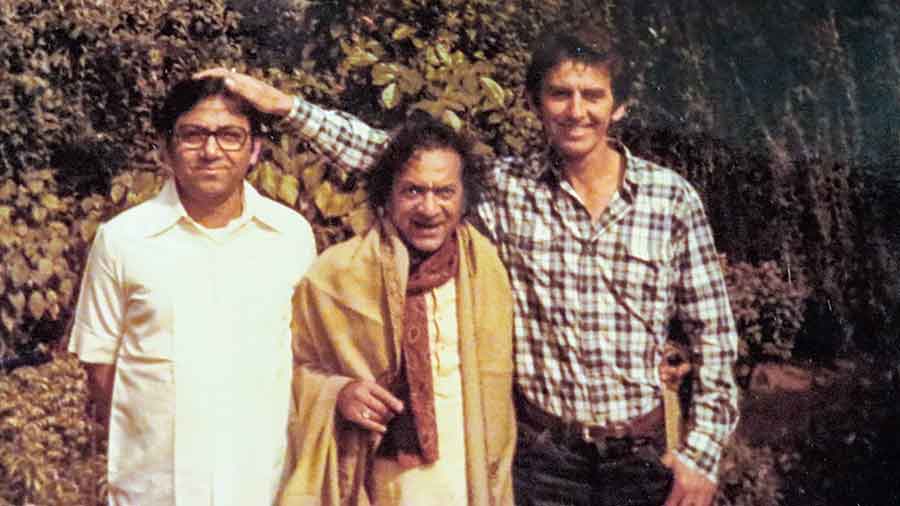He is the only Indian impresario Pandit Ravi Shankar has fondly referred to by name in his autobiography Raga Mela, edited and introduced by George Harrison. “Robin Paul, a man dear to me, has an organisation called Jalsaghar which over many years has successfully arranged concerts for me…” starts the paragraph on him in the book.
Seated in his DL Block house, Paul shows a photograph where the Beatle has placed his palm in mock benediction on Paul's head with Ravi Shankar standing between them. “That was at 95 Lodi Estate in Delhi, when Shankar was a Member of Parliament. Rajiv Gandhi had nominated him to the Upper House,” recalls the 86-year-old with a crystal clear memory. On the wall are several photographs of the sitar legend. One has him speaking to the young Prime Minister with Paul standing next to him.
“I have organised eight or nine concerts with Ravi Shankar, starting in 1976. He would not say no to me. ‘Ki bhnajchho (what are you devising)?’ he would ask me, off and on. “He knew I would come up with distinctive ideas.”
Paul’s classical music platform Jalsaghar was born on April 16, 1967. The initial shows were at small venues with the likes of thumri exponent Siddheswari Devi, Pt Jnanprakash Ghosh, Tansen’s last descendant Dabir Khan, Sagiruddin Khan, A. Kanan etc. “Our first auditorium show was at Rabindra Sadan in 1970 in tribute to tabla legend Kanthe Maharaj soon after his death, with Maharaj's disciple Natu Ganguly, sitarist Manilal Nag... It drew a full house, including Raichand Boral and Pahari Sanyal, and was announced on the radio in Sangbad Bichitra.”
Six years after this, he decided to approach Ravi Shankar. Reaching him was difficult. “His minders turned me away. I caught him at the gate on his way out of 20 Ballygunge Park, the house of Lala Sridhar, the owner of Usha Fan and DCM (Shriram), where he used to stay during his visits.”
What Paul proposed — a candle-lit whole-night solo concert at Marble Palace, accompanied by Pt. Kishan Maharaj — appealed to the sitarist. “He played for 12 hours with short breaks. I had kept a masseur in case he got fatigued but he did not.” He mentions this programme, on January 22, as his favourite in his autobiography. Two days later, he asked Paul to accompany him to Benaras. Thus was forged the link.
A memorable concert that Paul pulled off on February 29, 1992 for the silver jubilee of Jalsaghar was at Netaji Indoor Stadium with a stellar line-up of Ud. Bismillah Khan, Pt. Bhimsen Joshi, Pt. Birju Maharaj, Ud. Vilayat Khan and Pt. Ravi Shankar. On the tabla were Ud. Alla Rakha, Pt Kishan Maharaj, Pt, Samta Prasad and Ud. Zakir Hussain. Governor S. Nurul Hasan to Swami Lokeshwarananda to people from Bangladesh who had landed without tickets, the hall was packed.
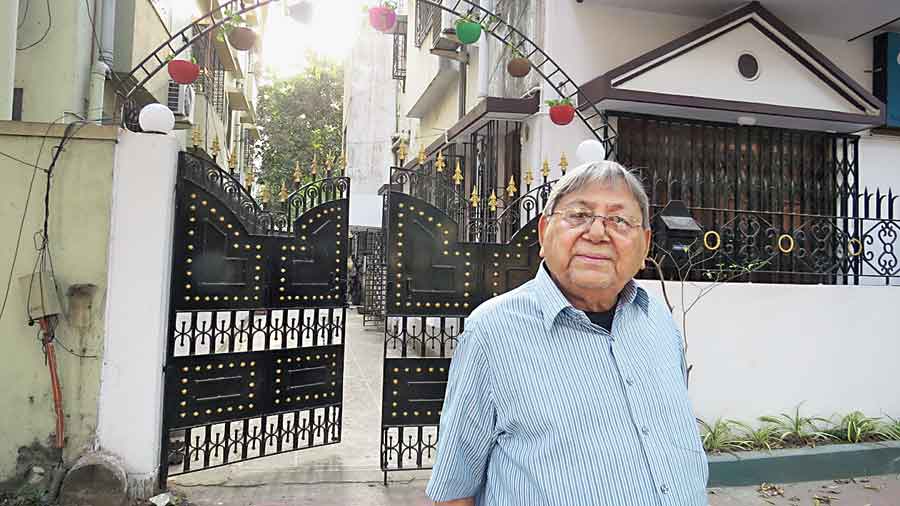
Robin Paul in front of his house in DL Block.
Picture by Sudeshna BanerjeeGetting Ravi Shankar and Vilayat to play on the same night was unthinkable, given the tussle between the two sitarists. Ravi Shankar had reportedly refused blank cheques earlier to play on the same stage as Vilayat. “When I approached him, Ravi Shankar agreed and asked for the last slot, traditionally reserved for the biggest name. He knew Vilayat would want that too. That is exactly what happened — Vilayat consented on condition that he be the last to play. When I went back to Ravi Shankar, he initially demurred but I reasoned with him that people were the most alert between 10pm and midnight. ‘You don’t want people to doze when you play, do you?’ I asked him. He accepted grudgingly but his performance was a huge success. In contrast, with an India-Australia World Cup cricket match Down Under to be telecast early next morning, many people left and Vilayat played to half-empty galleries. He was upset and later asked me for another concert where he would play earlier. ‘Ebar Robuda ke seshe dao (Let Robuda play at the end this time),’ he said. I told him such a concert could not be repeated.”
Paul’s correct interpretation of audience behaviour had impressed Ravi Shankar. “He said he had taken a risk by playing early and it had paid off. He also assured me that he would not refuse any of my programmes.”
He would play elsewhere under Paul’s Jalsaghar banner in places like Jorasanko Thakurbari, Dakshineswar temple and Victoria Memorial Hall as well. The latter was held in the aftermath of Prime Minister Indira Gandhi’s assassination in 1984, dedicated to peace.
When Ravi Shankar met Annapurna Devi
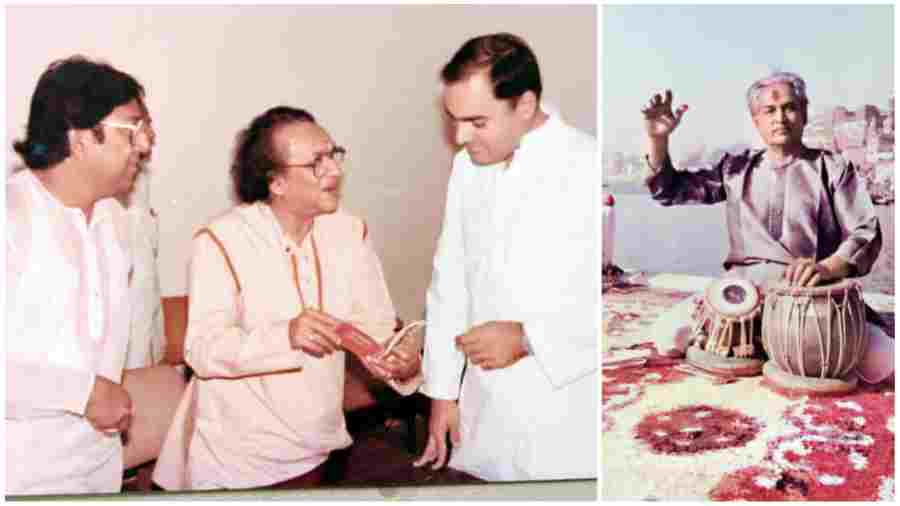
Pandit Ravi Shankar speaks to Prime Minister Rajiv Gandhi with Rabin Paul beside him. (Right) Pandit Kishan Maharaj plays the tabla on a boat in Varanasi.
Picture courtesy: Rabin PaulThe seeds of Jalsaghar, a classical music performance platform, were planted when Robin Paul was introduced by his father to Pt. Kishan Maharaj, the table maestro of the Benaras gharana, in 1958. “He used to put up in a room at 24, Mahendra Sarkar Street which my father had fixed for him. His meals went from our kitchen.” The young Paul used to accompany Maharaj to concerts by stalwarts with whom he would play. He even took him to his Benaras home. He was around 22 years old then.
“One day, I asked him if I could organise music programmes. He told me: 'Pehle payr jamao,' indicating that I had to build a strong foundation first in both finance and management.”
When Paul floated Jalsaghar in April 1967 nine years later, Maharaj readily agreed to become the emeritus chairman. The initial shows were at small venues. But he shored up courage to approach established names. “I went to Ud. Sagiruddin Khan's place in Ripon Lane, with a request for a solo sarangi recital. He and Keramatulla Khan stayed next door to each other and worked in All India Radio. He was known to be temperamental but was intrigued that a young man had approached him.” The show was held in the first floor hall of Elite Paper House in the Dharamtala area. Paul remembers paying Khan a princely sum of Rs 50.
He then went to Pt. Nikhil Banerjee. “He was touched that I wanted him to perform solo and that too with Kishan Maharaj on the tabla. No one had done so before and he himself was apprehensive if people would come to listen just to him. He even refused to accept advance payment. In those days, tickets were priced Rs 2 or 3. The show was houseful and I did three or four more solo shows with him,” Paul recalls.
Maharaj was a fixture in all Jalsaghar shows. “But once he could not make it for Ud. Amjad Ali Khan’s show at Kala Mandir in 1972.” Paul did not take a risk and got not one but two tabla players Khan knew from Delhi, Ananda Gopal Bandyopadhyay and Chandra Mohan, paying them Rs 150 each.
His relation with musicians was often beyond the professional. He had arranged two shows in consecutive years with Ud. Ali Akbar Khan in 1973-74.
“Years later, when Khan sahib’s wife, Zubeida boudi, needed a cataract operation, it was me that she called on his advice from the US where he was based. I was surprised that I was asked and not his son (Aashish) or disciples. I got it organised at Rotary Sankar Nethralaya in Sector V. The doctor suggested that the other eye be operated on as well. Khan sahib asked her to go ahead. Afterwards, she called me to their Gariahat home for lunch on Khan sahib’s birthday on Poila Baisakh as the only guest.”
The Annapurna episode
His intimacy with Pt. Ravi Shankar was on another level. “A messenger once came from Bombay asking me to fly over to meet Annapurna Devi, Panditji’s estranged wife. When I met her, she said she wanted Panditji to perform in Bombay for the Acharya Alauddin Music Circle at Birla Matushri Sabhaghar. I asked her why she couldn’t ask him herself or through her brother. She insisted that only I could persuade him. There would be no performance fees paid but she handed me a 5,000-rupee bundle as flight and hotel expenses.”
When Paul told Ravi Shankar about the concert, he flew into a rage. “Some days later when he broached the matter, I told him that he was free to refuse but it would be said he had dishonoured his guru’s memory. That made him change his mind, so much so that on the morning of the concert on February 10, 1980 he asked me to return the bundle of cash. When I went to do so she was alarmed, thinking he would not play but when I told her that he did not want any expense paid she started crying. She then asked me if I could record his recital for her. She would not attend it. She had not attended her brother’s recital either.”
The next morning, Paul went to Ravi Shankar’s Akashganga apartment at 89 Bulabhai Desai Road, where Annapurna stayed, to hand over the cassette of the recording to her. I suggested that she ask him at least to tea as thanksgiving. She was doubtful if he would come but asked me to invite him in the afternoon. He was surprised to hear of the invtation but agreed to go. His condition was that the door to Annapurna’s flat be ajar. “‘I would not stand and knock, waiting for her to open,’ he told me. I let her know that.”
Three of them, Nadu (Nader Chand) Mallik (who maintained his sitars), Ravi Shankar and Paul, went over in the afternoon. This meeting between the two after a gap of 17 years has been referred to in Oliver Craske’s biography, Indian Sun: The Life and Music of Ravi Shankar, with the author crediting Paul for making it happen.
On meeting him, she sought an increase in her monthly allowance and cost for repair of “the house, her car, electric lines, telephone line and what not”. “He agreed to pay for all that and also asked me to arrange for a subscription of Desh for her.”
Paul kept in touch with Annapurna Devi after this.
The next year, Saraswati puja was being held in Ravi Shankar’s Mumbai home. “I asked if prasad should be sent to Annapurna’s house. He left it to me to decide so I went over.
“I suggested that she invite Panditji for a meal. She said she had no one to shop for her as she bought her provisions from a vendor with a cart downstairs. When I offered to do so she paid me to buy provisions for lunch. When Panditji heard, he agreed to accept her invitation on February 10 provided the meal was cooked with bazaar he would pay for. So I duly shopped on behalf of both and landed two bags of vegetables at her doorstep.”
After the meal, Paul withdrew, letting them speak in private. After a while, Ravi Shankar stormed out. She had handed him a divorce letter. “He told me: ‘See, this is why I did not want to come. She used you!’”
Shankar’s lawyer K.C. Vajifdar was summoned. But I was unhappy with the letter he drafted as that was giving the impression that he was seeking the divorce. I offered to draft it. Later, the lawyer complimented me saying I had saved his client a lot in alimony by writing that he did not want the divorce but was consenting to her demand.”
After this incident, Paul snapped contact with Annapurna Devi.
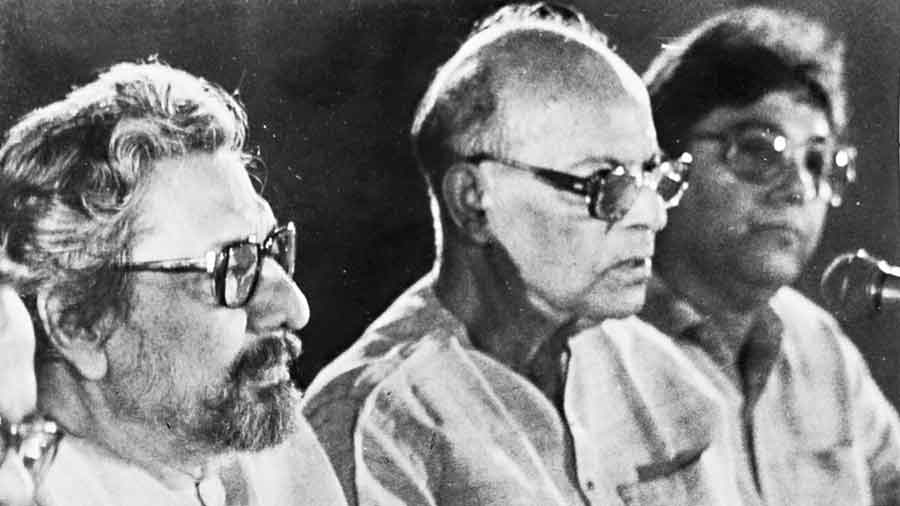
Sombhu Mitra (left) at the start of the oration at Calcutta University. Rabin Paul is to the extreme right.
Picture courtesy: Rabin PaulHealth hurdle
Other meetings he arranged went much better. Once Ravi Shankar had put up at the Ramakrishna Mission Institute of Culture at Gol Park. “He expressed a wish to meet Sombhu Mitra. When I told Sombhu babu, he agreed to come along. Ravi Shankar offered him muri-telebhaja. Sombhu babu was surprised that he took such homely fare. ‘Just because I play the sitar does not mean I eat meat all the time!’ he responded, laughing.”
Mitra told him it had been his long-term wish that Ravi Shankar compose the music for one of his plays. Shankar had worked with Utpal Dutt, on his plays Ferari Fouj and Angaar, and also a 1961 film called Megh. “Panditji immediately agreed, even promising to stay back in Calcutta for the work, if ever the occasion arose. But Sombhu babu said his health would not permit a new production.”
Paul got acquainted to Sombhu Mitra through the ENT specialist Abirlal Mukherjee, who was the president of Jalsaghor. “He had directed the film Ekdin Ratre. It had one scene where Raj Kapoor was climbing a pipe. I asked if he had shot the scene with the pipe placed horizontally. He was surprised that I had caught that. He asked me to come over but never with a tape recorder.”
He would chat for hours with Paul. “Such a handsome man he was, sitting bare-chested in a dhoti worn in lungi style. Once I requested him to revive Chand Boniker Pala. He said he would be unable to without Tripti Mitra, who used co-star in the play. They were already estranged. I suggested that he try out his daughter, Saoli. She was called and asked if she could. Being persuaded by her father, she agreed.”
Mitra wanted a homely ambience. “I told him that I was getting too many requests to be allowed to attend the play so it could not be done at home. Finally he agreed to stage it at Gyan Manch, on June 26, 1991.”
Earlier, in 1986, Paul had also asked Mitra to deliver a lecture as part of a Jalsaghar endowment oration series on music and performing arts at Calcutta University, which which Pt. Ravi Shankar (1983) and Salil Chowdhury (1985) had done and Tapas Sen (1990), Khaled Chowdhury (1992) and Mrinal Sen (2002) etc would do down the years. “I wanted to video record the speech. Mitra was dismissive of what a box camera would achieve. ‘Can you shoot on U-matic?' he asked. I said I would. On how many cameras, he asked. I said two. He said if the focus lamp went off, he would leave the stage. In those days, focus lamps would go off in about 10 minutes. I told him that I would use six lamps in batches of two with dimmer. He was impressed that I had a solution to every challenge.” The lecture went off well and Mitra wanted to see the recording, so Paul booked a studio. “The lecture was so brilliant that we brought out a book on it, titled Kake bole natyakola.”
Paul would visit the thespian on his birthdays with flowers. He went over a few months before his death as well. Mitra was fighting cancer and had stopped meeting people by then. “But on hearing my name, he came out and asked me not to plan anything with him as he was sensing his end was near. He died in a few months.
Making dreams come true on stage & off

Rabin Paul in his DL Block house leafing through Pt. Ravi Shankar’s autobiography in which he has been named.
Picture by Sudeshna BanerjeePaul recalls his success in making the wish of a great musician come true. He used to travel to Benaras a lot as Pt. Ravi Shankar was staying there. One day, word reached Paul that tabla player Pt. Shamta Prasad wanted to meet him. "I was from Kishan Maharaj's camp. Though they were related, he was at loggerheads with Shamta Prasad. Still I went. He stayed at Kabir Chaura, where all the musicians stayed.”
He told Paul it was his last wish in life to play with Pt. Ravi Shankar and Ud. Ali Akbar Khan. “I told him if I could come up with a date he had to cancel everything and come. Soon Ravi Shankar had a programme in Lucknow. I tipped off Shamta Prasad to be there. In the morning when Ravi Shankar heard who I had lined up to accompany him he got agitated. 'He plays so boisterously that he would ruin my recital,' Panditji lamented. Still he asked me to bring him over. Shamta Prasad came with palms joined. 'You are not to drink a drop before getting on stage. I will send you off stage if I smell liquor,' Ravi Shankar told him sternly, asking me to keep an eye on him.”
I came up with a plan to contain Shamta Prasad. “His weakness was tempo, to cover which he plays vigorously. So I told Panditji to play a long alaap where tabla would have no role and then stick to teentaal, of which the percussionist was a master. That is exactly what Panditji did. The show was a great success.”
The same plan was put in place successfully when Paul lined up Shamta Prasad with an apprehensive Ud. Ali Akbar Khan too in another show, in Durgapur. “That night I sent instruction that his two sons be housed in a far wing of the guest house where we stayed, so that they could not supply liquor to their father.”
Power of music
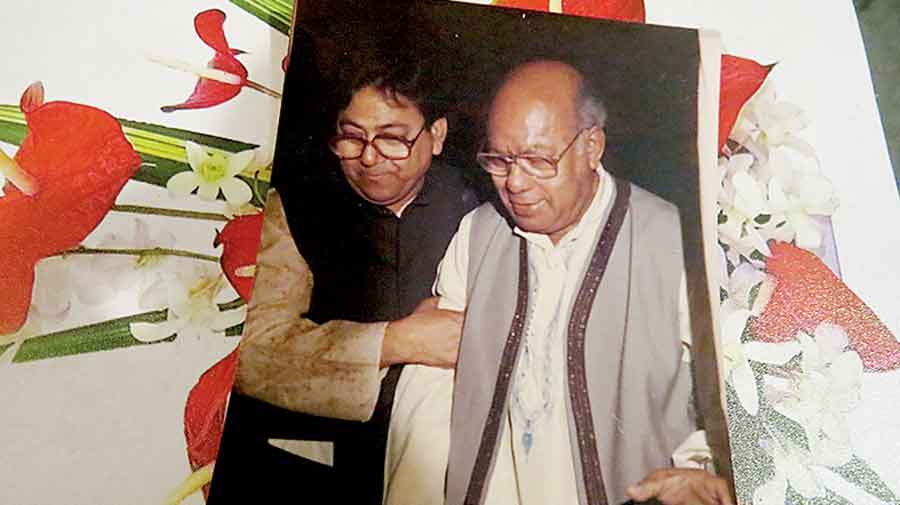
Ud. Ali Akbar Khan with Rabin Paul.
Picture courtesy: Rabin Paul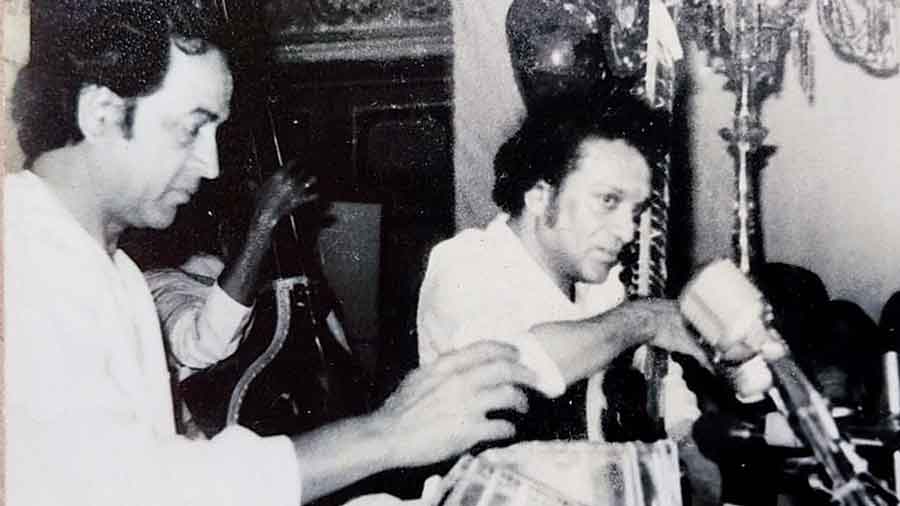
Pt. Ravi Shankar plays under candle light at Marble Palace with Pt. Kishan Maharaj on the tabla at an event organised by Rabin Paul. The sitar legend has described the programme as his favourite.
Picture courtesy: Rabin PaulDespite having spent years in the company of doyens, Paul is still in awe of the hold a musician has on common people. “On the day of his departure after a star-studded concert at Netaji Indoor stadium in 1992, Ud. Bismillah Khan, who used to put up near Nakhoda Masjid, informed me that he had lost the return tickets. He had come with a big group and there was no way anything could be done. He met the ticket checker at the platform and reported the matter. The checker was overwhelmed on meeting the sehnai legend and immediately said since the names were all on the passenger list, he need not worry. I stood amazed as the train sped off carrying over a dozen ticketless passengers, just because one of them was Bismillah Khan.”
Norah Jones as playmate
Paul brings out a photograph of two children with playthings. “One is my son. Can you guess who the other is?” he asks. On failing to get the correct response, he points out that the other child was Norah Jones, the Grammy Award winning singer-songwriter. This was during the India visit of Ravi Shankar’s ???? Sue Jones. “This picture is at my Shakharitola Street residence.”

Pt. Ravi Shankar kisses his daughter Norah Jones.
Picture courtesy: Rabin PaulShankar had not accompanied his wife and daughter??? and Paul was deputed to take care of them. “A flat had been rented for them on Middleton Street. The kid loved to ride ponies, so I used to take her to the race course area every morning for a ride. They stayed for about seven days,” Paul recalls.
Bedrock of trust
Paul says in his entire career as impresario, he never drew up a contract or got any musician to sign anything. “It was all based on word of mouth and mutual trust. I have never failed in delivering what I promised. “Ravi Shankar used to ask me why Alu bhai (Ali Akbar Khan) loved me as much as he did. 'He speaks so much about you!' I am blessed that almost all the great musicians treated me so well. Rather it is now that I face problems handling today's lot. Ektu bajate sikhlo ki na sikhlo, boro boro katha!”
At the age of 86, Paul's zest to promote classical music has not ebbed. “I need some young people which I have found in New Town,” he smiles.


